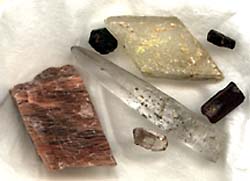This is an old revision of this page, as edited by Menchi (talk | contribs) at 04:26, 10 January 2003 (wikify further). The present address (URL) is a permanent link to this revision, which may differ significantly from the current revision.
Revision as of 04:26, 10 January 2003 by Menchi (talk | contribs) (wikify further)(diff) ← Previous revision | Latest revision (diff) | Newer revision → (diff)Minerals are natural compounds formed through geological processes. The term "mineral" encompasses not only the material's chemical composition but also the crystalline atomic structure. Minerals range in composition from elements and simple salts to very complex silicates (with most organic compounds usually excluded), with thousands of known forms.
What is a mineral ?
A mineral crystalline structure refers to the orderly spatial arrangement of atoms in its molecular structure. There are 14 basic arrangements of atoms in three dimensions, and all mineral structure recognised till now fit in one of these 14 arrangements.
Chemistry and structure define together a mineral. In fact, two or more minerals may have the same chemical composition, but different structures. For example, pyrite and marcassite are both iron sulfide. Similarly, some minerals have different chemical compositions, but the same structure : for example, quartz (made from silicon and oxygen) and berlinite (aluminium and phosphorous).
Structure influences greatly a mineral physical properties. For example, though diamond and graphite have the same composition, graphite is very soft, while diamond is the hardest of all minerals.
To be classified as a true mineral, a substance must be a solid and have a crystal structure. Mineral-like substances that don't strictly meet the definition are sometimes classified as mineraloids.
The study of minerals is called mineralogy.

Photo from US Geological Survey
Examples of minerals
Some important rock-forming minerals include the feldspars, quartz, olivines, pyroxenes, garnets, micas, and calcite. Other well-known minerals include the wide variety of gemstones.
Minerals and rocks
Minerals must be distinguished from rocks. A mineral is a chemical compound with a given composition and a defined atomic structure. A rock is a mixture of one or several minerals, in varying proportions.
Physical properties of minerals
There are about 3000 different mineral species known, and classifying them range from simple (for a couple of hundred) to very difficult. A mineral can be identified by several physical properties, some of them being sufficient to identify a mineral. However, some modern techniques, such as chemical analysis and X-ray diffraction can help, though costly, time-consuming, and even sample-damaging.
Physical properties commonly used are :
- hardness : the physical hardness of a mineral is usually measured on the Mohs scale of mineral hardness
- luster (indicate the way a mineral's surface interacts with light)
- color
- cleavage (describe the way a mineral may come apart or cleave in different ways)
- fracture (describe how a mineral breaks other than along natural cleavage planes)
- specific gravity (relate the mineral weight to the way or an equal volume of water)
- other properties : luminescence (response to ultraviolet light), magnetism, radioactivity, tenacity (response to mechanical induced changes of shape or form)
Trying to list all the minerals here would probably be counter-productive; maybe they can be linked from their chemical compositions (eg Silicon dioxide->Quartz, Chalcedony, Opal)?
Dietary mineral
Dietary mineral refers to inorganic compounds necessary for life and good nutrition.
Some of these are scientific minerals as salt; others are elements, as potassium, calcium, iron, zinc, magnesium, copper.
These can be naturally occurring in food or added in elemental or mineral form to food, as calcium carbonate, iron fillings, etc.
Some of these additives are from natural sources as ground oyster shells for calcium carbonate.
Sometimes minerals are added to the diet separately from food, as vitamin and mineral supplements and in dirt eating, called pica or geophagy.
Selected Minerals
- Agate
- Analcim
- Barite
- Hematite
- Kainite, Kalsilite, Kamacite, Kaolinite, Keilhauite, Kernite, Kobellite, Kunzite
- Zircon